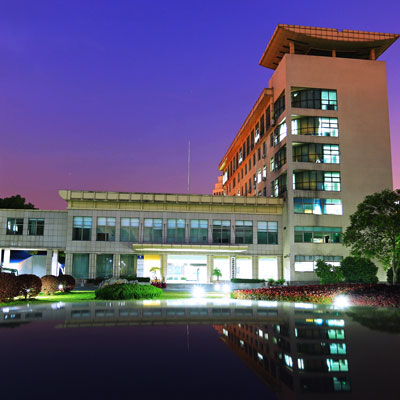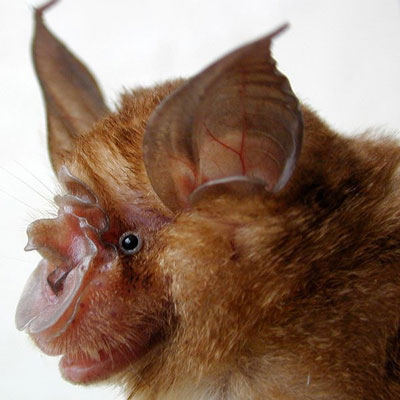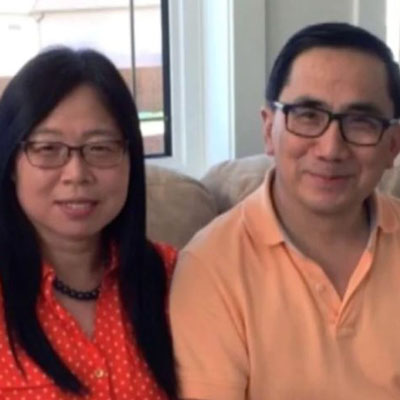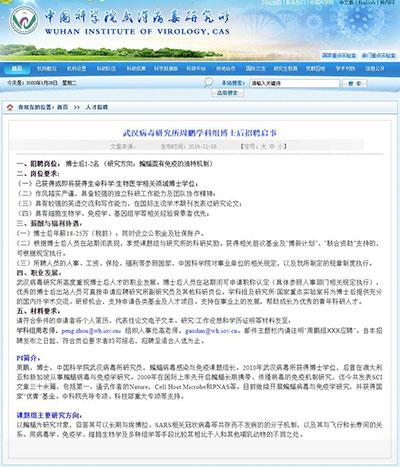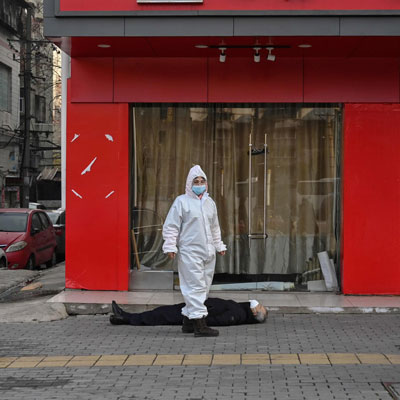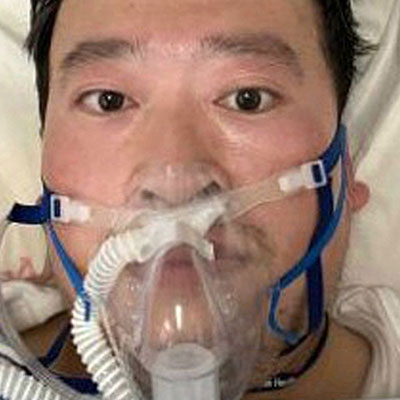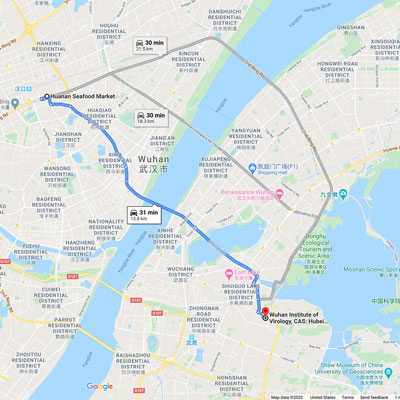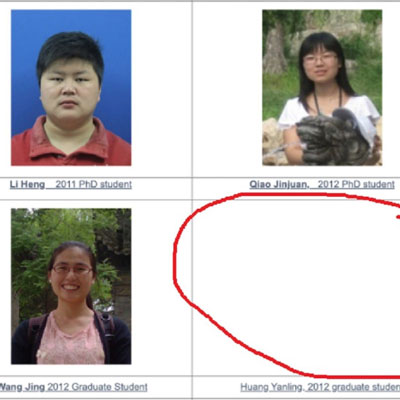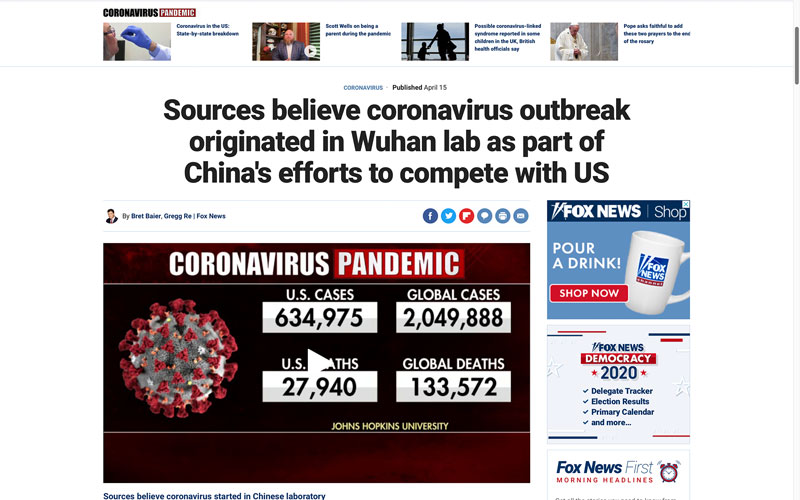The Chinese government claims that naming China as the origin of the novel coronavirus is “hasty and reckless and totally irresponsible.“ As this timeline shows, however, there is a 23-year history that lends credence to the theory that China is actually experimenting with coronaviruses for use in biological weapons.
William Gibson turned the concept of “pattern recognition” into a book. This timeline will help you recognize certain patterns that permeate three diseases that originated in China. Pay particular attention to the dates these pandemics really flared up. Also, note the overwhelming proof China’s researchers have themselves provided pointing to genetic engineering as the most likely circumstance leading up to the accidental, or perhaps intentional, release of the novel coronavirus, aka Covid-19, 2019-nCoV or SARS-CoV-2.
Bird Flu or Avian Influenza A (H5N1)
In May 1997, a mysterious disease began spreading through China’s Guangdong province, dubbed “Bird Flu” or Avian Influenza A (H5N1). The disease’s origin was traced to a “zoonotic jump” — a transmission of an animal pathogen to humans — in this instance poultry and wild birds. Avian influenza has a high mortality rate of 60%, but luckily minimal community spread.
09-May-97
A previously healthy three-year-old boy develops a fever, sore throat and cough in Hong Kong. On May 21, the boy dies from “acute respiratory distress due to viral pneumonia.” Three months later the infection is identified as H5N1 avian influenza. The virus had been detected in geese in 1996 in China’s Guangdong province and in chickens in Hong Kong in March 1997.
06-Nov-97
A two-year-old boy with a congenital heart disease develops a high fever, cough and sore throat and was diagnosed with bird flu.
20-Nov-97
A previously healthy 13-year-old girl develops fever, sore throat, and cough. Hospitalized on November 26 due to pneumonia, she is transferred to ICU and placed on mechanical ventilation the next day. She dies 25 days later. Of the first 18 patients, six of whom died, 10 (55%) are female and 11 (61%) are 14 years of age and under.
29-Dec-97
Hong Kong begins the wholesale slaughter of 1.3 million birds, the first phase of a plan to contain the mysterious “bird flu“ virus.
01-Jan-00
CIA publishes “The Global Infectious Disease Threat and Its Implications for the United States” report, predicting that “New and reemerging infectious diseases will pose a rising global health threat and will complicate U.S. and global security over the next 20 years.”
01-Mar-01
Dr. Anthony Fauci releases “Clinical Infectious Diseases” in which he presciently predicts, “The appearance of bird-to-human transmission of H5N1 influenza A virus in Hong Kong in the winter of 1997–1998 was a cogent reminder of the ever-present threat of a new strain of influenza A virus entering a population that is relatively naïve for the microbe in question.”
01-May-02
In “Outbreak of Avian Influenza A(H5N1) Virus Infection in Hong Kong in 1997” report, Dr. Paul Chan writes that “The clinical spectrum of H5N1 infection ranges from asymptomatic infection to fatal pneumonitis and multiple organ failure.”
08-Jan-14
Canada reports first human case of avian influenza A (H5N1) infection ever detected in North or South America. The patient, who died on January 3, 2014, recently traveled to Beijing, China.
SARS or Severe Acute Respiratory Syndrome (SARS-CoV)
Coronaviruses usually cause mild to moderate upper-respiratory tract illnesses, such as the common cold. There are hundreds of coronaviruses, most of which circulate among such animals as pigs, camels, bats and cats. Sometimes these viruses jump to humans, dubbed a spillover event, and cause disease. In the past two decades, three new coronaviruses have emerged that cause serious illness and death. The first, in November 2002, was the SARS-CoV coronavirus, which causes severe acute respiratory syndrome (SARS) and resulted in the 21st century’s first global pandemic. A Journal of Virology article reported engineering the spike protein from a civet strain, although the latest genome sequencing suggests it was derived from a newly discovered bat coronavirus (BtCoV).
16-Nov-02
SARS (severe acute respiratory syndrome) detected in a farmer in China’s Guangdong province, near Hong Kong.
28-Jan-03
The 8-year-old daughter of a 33-year-old Hong Kong resident develops pneumonia in Fujian, China and is admitted to a local hospital but dies on February 4.
31-Jan-03
A fish seller, Zhou Zuofen, checks into Sun Yat-sen Memorial Hospital in Guangzhou, Guangdong Province, where he infects 30 nurses and doctors, including Liu Jianlun, a 64-year-old doctor from Zhongshan University in Guangzhou.
10-Feb-03
In early February, Hong Kong media report on a mysterious virus sweeping through Guangdong. Chinese authorities issue denials and impose a media blackout. Propelled by text messages, panic buying breaks out in Guangdong with grocery stores running out of white vinegar, which is rumored to kill germs and help prevent the spread of pneumonia.
11-Feb-03
WHO officially informed with report of 305 cases of acute respiratory syndrome from an unknown cause, including five deaths and 105 healthcare workers. The 33-year-old father is admitted to the Princess Margaret Hospital.
17-Feb-03
The 33-year-old Hong Kong man, who had traveled with his family to Fujian Province, China in January, dies of unknown causes in Hong Kong.
21-Feb-03
Dr. Liu Jianlun feels unwell but attends a family wedding in neighboring Hong Kong, checking into Room 911 at the Metropole Hotel.
22-Feb-03
Feeling increasingly sick, Dr. Liu checks into the Kwong Wah Hospital, where he warns the medical staff that he fears he has contracted a “very virulent disease.” Liu dies on March 4. Soon after, 23 other Metropole Hotel guests fall ill, including seven from the ninth floor. One of those staying on the ninth floor is a Chinese-American resident of Shanghai named Johnny Chen, who soon travels to Hanoi, Vietnam.
26-Feb-03
Chen is admitted to The French Hospital in Hanoi, where he infects more than 38 staff members including Dr. Carlo Urbani, a WHO infectious disease specialist. Chen dies on March 13.
04-Mar-03
A 27-year-old man who visited a guest on the ninth floor of the Metropole Hotel is admitted to the Prince of Wales Hospital in Sha Tin, Hong Kong where he infects over 99 healthcare workers.
05-Mar-03
Dr. Liu’s 78-year-old grandmother, Kwan Sui-Chu, flies home to Toronto, Canada, where she is met by her son. She dies on March 5. Her son, Tse Chi Kawi, dies at Scarborough Grace Hospital on March 13 after spreading the disease there.
11-Mar-03
Dr. Carlo Urbani flies to Bangkok, Thailand to attend a medical conference. Feeling ill during the flight, Urbani immediately goes to a hospital upon landing. Urbani dies on March 29.
04-Apr-03
Dr. Jiang Yanyong sends an email to CCTV4 (Chinese Central Television) and Phoenix TV (Hong Kong) reporting that the Chinese government is drastically understating the SARS threat.
06-Oct-03
An analysis of SARS deaths in Singapore finds a disturbing trait of the novel coronavirus disease, two of eight patients (25%) autopsied experienced sudden unexpected deaths, a phenomenon that would later be observed in Covid-19 deaths in China and Indonesia.
07-Jan-04
China culls all Asian Palm Civets from markets. Civets are thought to be the reservoir for the disease after a WHO team found SARS in civet cages in a restaurant where two workers came down with the disease.
Covid-19 (2019-nCoV or SARS-CoV-2)
In November 2019, a mysterious pneumonia-like disease is detected in Wuhan, a city of 11 million located in Central China’s Hubei province. The most common symptoms are fever (98%), cough (76%), and myalgia or fatigue (44%). Fifty-five percent develop dyspnea, shortness of breath, eight days on average after the onset of symptoms. Beijing claims the deadly coronavirus outbreak began at Huanan Seafood Market, also known under the name of “South China Seafood Market,” a so-called “wet market” in Wuhan, where live animals were often sold. The official line: the virus was passed to humans through wildlife sold as food.
Dec-06
Zhengli Shi, a researcher at Wuhan Institute of Virology, co-authors an “Emerging Infectious Diseases” article with Peter Daszak describing whole-genome sequences of two novel bat coronaviruses from Chinese horseshoe bats that target the ACE2 receptor, just like Covid-19.
30-Oct-13
Zhengli Shi and Peter Daszak team up again to author a Nature article, entitled Isolation and characterization of a bat SARS-like coronavirus that uses the ACE2 receptor — offering strongest evidence to date that Chinese horseshoe bats are natural reservoirs of SARS-CoV.
09-Nov-15
Two Wuhan Institute of Virology scientists, Xing-Yi Ge and Zhengli-Li Shi, use reverse genetics to generate a chimeric virus (one that has been created by combining cells of more than one distinct genotype) closely resembling the novel coronavirus Covid-19: “On the basis of these findings, we synthetically re-derived an infectious full-length SHC014 recombinant virus and demonstrate robust viral replication both in vitro and in vivo.” The Nature Medicine article also mentions, “Human lungs for HAE cultures were procured under University of North Carolina at Chapel Hill Institutional Review Board–approved protocols.”
22-Feb-17
The Wuhan Institute of Virology, China’s first biosafety level-4 lab (BSL-4), is certified to work on the most dangerous pathogens. Observes Nature, “But worries surround the Chinese lab, too. The SARS virus has escaped from high-level containment facilities in Beijing multiple times.” The Wuhan Institute of Virology is the only BSL-4 virology lab in China staffed with two Chinese virologists, Zhengli Shi and Xing-Yi Ge, who both previously worked at a University of North Carolina at Chapel Hill lab, which had already bio-engineered an incredibly virulent strain of bat coronavirus.
30-Nov-17
As Nature breathlessly tells it, “After a detective hunt across China, researchers chasing the origin of the deadly SARS virus have finally found their smoking gun. In a remote cave in Yunnan province, virologists have identified a single population of horseshoe bats that harbours virus strains with all the genetic building blocks of the one that jumped to humans in 2002, killing almost 800 people around the world.” That report was based on an article, entitled, “Discovery of a rich gene pool of bat SARS-related coronaviruses provides new insights into the origin of SARS coronavirus,” published in San Francisco-based “PLOS Pathogens’ and jointly funded by National Natural Science Foundation of China. And wielding the smoking gun, besides a cast of usual suspects (Xing-Yi Ge and Peter Daszak) was none other than Shi Zhengli (Zhengli Shi in Chinese), a virologist who is often called China’s “bat woman” by her colleagues because of her virus-hunting expeditions in bat caves over the past 16 years.
19-Jan-18
U.S. Embassy in Beijing takes unusual step of repeatedly sending U.S. science diplomats to the Wuhan Institute of Virology. One visit raises so many red flags, that a cable is sent noting, “a serious shortage of appropriately trained technicians and investigators needed to safely operate this high-containment laboratory.”
27-Mar-18
The Wuhan Institute of Virology issues a news release in English after the last of the U.S. Embassy visits. The news release was removed the week of April 6, 2020, although it remains archived on the internet.
05-Jul-19
Chinese virologist Qiu Xiangguo and her biologist husband Cheng Keding are escorted from the National Microbiology Lab (NML) in Winnipeg, Canada’s only BSL-4, biosafety level-4, laboratory, certified to handle the world’s deadliest diseases, including Ebola and SARS. Four months earlier, a shipment of two exceptionally virulent viruses dealt with at NML – Ebola and Nipah – found its way to China from NML, officially categorized as a possible “policy breach.” A subsequent investigation by GreatGameIndia linked the shipment to Qiu and Cheng, who reportedly are agents of China’s biological warfare program.
07-Oct-19
On May 9, 2020, NBC reports that based on “three sources briefed on the matter” a private analysis of mobile phone geolocation data reveals that the Wuhan Institute of Virology was shut down from Oct. 7 through Oct. 24, 2019, due to a “hazardous event” that happened sometime between Oct. 6 and Oct. 11.
17-Nov-19
The South China Morning Post reports that, according to government data it has seen, a 55 year-old may have been the first person to contract Covid-19 on November 17 in Wuhan, China. A much earlier date than any official accounts.
18-Nov-19
The Wuhan Institute of Virology posts a job opening that seeks to fill “1-2 post-doctoral fellows” who will “take bats as the research object and provide answers regarding the molecular mechanism that can co-exist with Ebola and SARS-associated coronaviruses for a long time without causing disease, and its relationship with flight (aerosols) and longevity. Virology, immunology cell biology and multiple comics (refers to biological science study fields that end with -omics) are used to compare the differences between humans and other mammals.” Candidates are to send their resumes to Peng Zhou (周鹏) Ph.D., the “Leader of the Bat Virus Infection and Immunization Group” at the Wuhan Institute of Virology. Chinese job posting shown here.
01-Dec-19
An official report in The Lancet (Lead Author: Prof. Chaolin Huang) says the symptom onset date of one of the first officially confirmed Covid-19 patients was Dec 1, 2019. Professor Wu Wenjuan, co-author of The Lancet report and a director of intensive care units at Wuhan’s Jinyintan Hospital, tells the BBC that “patient zero” was a pensioner in his 70s who was bed-ridden due to a stroke but who also had no connection to the Huanan Seafood Market prior to falling ill.
08-Dec-19
The Wall Street Journal cites Wuhan Municipal Health Commission public notices announcing the first confirmed Covid-19 case: a person surnamed Chen who fell sick on December 8 but had fully recovered and been discharged from the hospital. That person denied going to the Huanan Seafood Market, it said.
10-Dec-19
Wei Guixian, a merchant in this city’s Huanan Seafood Market, starts to feel sick, reports The Wall Street Journal. Eight days later, the 57-year-old lies barely conscious in a hospital bed, one of the first suspected cases in a coronavirus epidemic.
12-Dec-19
Wu Wenjuan, a doctor at Wuhan’s Jinyintan Hospital, tells The Wall Street Journal that among the earliest cases were four people in the same family, including a 49-year-old Huanan Seafood Market vendor and his father-in-law. The vendor got sick on Dec. 12, while the father-in-law, who had no exposure to the Huanan Seafood Market, fell ill seven days later.
16-Dec-19
The first of 41 Covid-19 cases studied in The Lancet report are admitted to the “designated hospital,” Jin Yin-tan Hospital (see Dec. 1). Twenty-seven (66%) of 41 patients report being exposed to Huanan Seafood Market, conversely 34% were not exposed to the Huanan Seafood Market.
24-Dec-19
The Wuhan Institute of Virology adds a second job posting with this Google-translated description: “Long-term research on the pathogenic biology of bats carrying important viruses has confirmed bats as the origin of major new human and livestock infectious diseases such as SARS and SADS.” This time, applicants are asked to send their resumes to Zhengli Shi, the “bat woman.”
30-Dec-19
Li Wenliang, a 34-year-old ophthalmologist who works at Wuhan Central Hospital, posts a story on WeChat about a mysterious new acute respiratory syndrome disease.
31-Dec-19
An official alert identifying the coronavirus is issued by local health authorities and the Huanan Seafood Market is shut down on Jan 1, 2020. News reports show authorities constructing a sealed enclosure around the Huanan Seafood Market’s entrance, and removing evidence. No one has ever been allowed access to the market since.
03-Jan-20
Police accuse Li Wenliang of spreading rumors and force him to write a statement admitting to “illegal behavior.”
07-Jan-20
Chinese President Xi Jinping personally orders officials to control outbreak. Authorities, however, keep denying Covid-19 can spread between humans and proceed with a Chinese Lunar New Year banquet involving tens of thousands of families in Wuhan. Hong Kong’s Ming Pao daily reports that curbing the spread was not at the top of the agenda when Xi and other members of the party’s upper echelon sat down for a Politburo meeting on January 7. Citing its source, top leaders were opposed to any measures “that may mar the festive vibe and make the public panic.”
12-Jan-20
The Shanghai laboratory where researchers published the world’s first genome sequence of the coronavirus is closed for “rectification.”
14-Jan-20
Parroting China, WHO erroneously tweets: “Preliminary investigations conducted by the Chinese authorities have found no clear evidence of human-to-human transmission of the novel #coronavirus (2019-nCoV) identified in #Wuhan, #China 🇨🇳.”
21-Jan-20
First case of 2019 Novel Coronavirus (2019-nCoV) in the U.S. is confirmed in a Washington state patient who returned to the U.S. from Wuhan on January 15.
23-Jan-20
China locks down Hubei province, including 18 cities housing 56 million people, but not before some 5 million residents reportedly leave Wuhan before the Spring Festival holiday.
24-Jan-20
A citizen journalist — Chen Qiushi, a Beijing human rights lawyer — goes to Wuhan to investigate China’s response to Covid-19. His videos tell the truth: “Why bother going to a hospital when you can’t get a test? There are only 10,000 test kits but Wuhan has a population of 11 million. Even if they have enough test kits, they still need beds. Even beds are not enough, they still need doctors, so the situation is very dangerous with so many problems yet to be solved.” Chen Qiushi was last seen on February 6. #FindQiushi
28-Jan-20
It reads like movie script for a crime thriller. Instead, it’s an FBI criminal complaint filed against Dr. Charles Lieber, 60, Chair of the Department of Chemistry and Chemical Biology at Harvard University. Lieber alledgedly received $158,000 per year for living and personal expenses paid for by Wuhan University of Technology and $50,000 per month in salary from China’s Thousand Talents Plan, which, according to the FBI, “seeks to lure foreign experts to China and reward individuals for stealing proprietary information.” In August 2018, U.S. Customs and Border Protection agents stopped Chinese biologist Zaosong Zheng at Boston Logan Airport with 21 stolen vials of biological research hidden in a sock in his luggage. Then there’s Yanqing Ye, a Lieutenant of the People’s Liberation Army (PLA), who falsely identified herself as a student while conducting reconnaissance for National University of Defense Technology, a top military academy directed by the Chinese Communist Party. In November 2018, U.S. CBP agents stopped a Chinese biologist at Detroit Metro Airport with three vials labeled “Antibodies” in his luggage. According to Yahoo News, the vials contained Middle East Respiratory Syndrome (MERS) and Severe Acute Respiratory Syndrome (SARS). Still not convinced China is experimenting with biological warfare?
30-Jan-20
Journalists from Agence France-Presse captured the body of a man laying dead in a Wuhan street, reports The Guardian. People suddenly collapsing in public places are scenes frequently captured in Wuhan, and except for Indonesia, nowhere else, suggesting that the virus strain circulating in Wuhan is particularly virulent. Sudden unexpected death syndrome was a phenomenon reported in a Singapore study of the SARS-CoV virus (see 06 October 2003).
06-Feb-20
Dr. Li Wenliang dies from the Coronavirus, sparking an “explosion of anger, grief and demands for freedom of speech among ordinary Chinese,” according to The Guardian. China’s National Supervisory Commission, the country’s top anti-corruption body, promises to send a special team to Wuhan to investigate the circumstances around Dr. Li’s death. Read Li’s posthumous profile at The Lancet.
09-Feb-20
Fang Bin, a Wuhan businessman who began posting videos about the outbreak to “report on the actual situation here,” and who became well known after releasing a video clip of dead bodies in a van outside a major hospital on February 1, is taken away by plain-clothes police. #FindFangBin
12-Feb-20
After removing senior Wuhan health officials, including the deputy head of the government-run Red Cross charity, Zhang Qin, Chinese state media report that China’s chief biochemical weapons defense expert, Chen Wei, a major general in the People’s Liberation Army, will lead the efforts against the novel coronavirus pathogen. According to People’s Liberation Army Daily, Chen has been researching coronaviruses since the 2003 SARS outbreak, as well as Ebola and anthrax.
14-Feb-20
Perhaps the most incriminating evidence is posted to ResearchGate, entitled “The possible origins of 2019-nCoV coronavirus,” written by Botao Xiao and Lei Xiao. The authors draw four conclusions:
- Bats carrying CoV ZC45 were originally found in Yunnan or Zhejiang province, both of which are more than 900 kilometers away from the Huanan Seafood Market.
- We screened the area around the seafood market and identified two laboratories conducting research on bat coronavirus. Within ~280 meters from the market is the Wuhan Center for Disease Control & Prevention (WHCDC), which hosts animals in laboratories for research purposes, one of which specialized in pathogen collection and identification. In one study, 155 bats, including Rhinolophus Affinis, were captured in Hubei province, in another, 450 bats were captured in Zhejiang province.
- WHCDC is also adjacent to the Union Hospital where the first group of doctors were infected during this epidemic.
- The second laboratory was ~12 kilometers from the Huanan Seafood Market and belonged to Wuhan Institute of Virology, Chinese Academy of Sciences. This laboratory reported that Chinese horseshoe bats were natural reservoirs for the severe acute respiratory syndrome coronavirus (SARS-CoV), which caused the 2002-3 pandemic.
Given this collection of pertinent facts, it’s not surprising that the paper was removed from ResearchGate (the above link goes to a copy on SCRIBD), and both researchers deleted their ResearchGate profiles. One can rest assured that the April 11 crackdown is the result of this research paper. We are also sure that both researchers have been arrested by Chinese police.
15-Feb-20
Wuhan Institute of Virology laboratory, located just 14 km, or 9 miles, from the Huanan Seafood Market, becomes a trending topic on Weibo after accounts claim one of the institute‘s graduates, female virologist Huang Yanling, was “patient zero.“
16-Feb-20
Wuhan Institute of Virology issues statement denying rumors circulating on WeChat and Weibo that suggest real “patient zero” is actually female virologist Huang Yanling, who works The Wuhan Institute of Virology. The institute insists Yanling “left the city in 2015 and was in good health” while refusing to release more information about her for “privacy reasons.” A Weibo user, who claims to be institute researcher Chen Quanjiao, accuses institute Director Wang Yanyi of leaking the virus. The institute says allegation was fabricated and user who posed as Chen was an impostor. Police claim Weibo poster was based outside of China.
17-Feb-20
Shortly after disputing social media rumors saying, “Recently there has been fake information about Huang Yanling, a graduate from our institute, claiming that she was patient zero in the novel coronavirus;” and then adding that Huang had left Hubei province in 2015 was in good health and had not been diagnosed with disease, the Wuhan Institute of Virology deleted Huang’s profile from its website as this image shows.
22-Feb-20
Professor Fang Chi-tai of National Taiwan University reports that 2019-nCoV is 96% similar to the bat virus RaTG13, which is known to be housed at the Wuhan Institute of Virology lab. Fang says that this in itself does not prove that the novel coronavirus was man-made, as a genetic similarity of 99% would be required to declare them identical. He notes, however, that 2019-nCoV research has found that the key difference between RaTG13 and SARS-CoV-2 is that the latter has four additional amino acids not found in any other coronaviruses. Fang says these four amino acids make the disease easier to transmit, suggesting it’s a chimeric virus (one that has been created by combining cells of more than one distinct genotype).
02-Mar-20

In January and February 2020, China Mobile, China’s largest mobile phone carrier with more than 940 million subscribers, suddenly began losing subscribers, 862,000 in January and a whopping 7.2 million in February, for a total loss of 8.1 million in just two months. During 2019, China mobile consistently added new subscribers each month, reaching a peak in December 2019 with 3.7 million new subscribers. China’s Ministry of Industry and Information Technology (MIIT) confirmed this large subscriber loss on March 19 when it reported that the total number Chinese mobile phone subscribers dropped 21 million. As of April 17, China Mobile has not provided an update on March subscribers, unusual for a publicly-traded company.
26-Mar-20
Chinese investigative outlet Caixin reveals that as Wuhan mortuaries open back up, photos show a far greater number of urns than reported deaths. In one photo, a truck loaded with 2,500 urns can be seen arriving at the Hankou Mortuary. The driver claims he delivered a similar amount of urns the previous day. Another image shows seven 500-urn stacks inside the mortuary, equal to the remains of 3,500 deceased. Funeral homes inform families that they will try to complete cremations before the traditional grave-tending festival of Qing Ming on April 5, a 12-day period starting March 23. Assuming all seven Wuhan funeral homes distribute 3,500 urns each day, that suggests a total of 42,000 urns are given out during this time.
27-Mar-20
Wen-Bin Yu, together with Guang-Da Tang, Li Zhang, Richard Corlett, uploads a preprint (scientific name for non-peer-reviewed publicationos) entitled Decoding the evolution and transmissions of the novel pneumonia coronavirus (SARS-CoV-2) using whole genomic data to ResearchGate. The research paper contains this observation, “We suggest that SARS-CoV-2 may have already circulated widely among humans in Wuhan before December 2019, probably beginning in mid to late November.” More importantly, lead author Wen-Bin, who is affiliated with the Chinese Academy of Sciences in Mengla, Yunnan, offers this conclusion after studying 93 genomes of SARS-CoV-2 from the GISAID EpiFlu database and identifying 58 haplotypes (a set of DNA variations that tend to be inherited together), concludes “Genomic evidence did not support the Hua Nan market as the birthplace of SARS-CoV-2.”
05-Apr-20
The possibility that the novel coronavirus was developed in a lab using an intermediate host, a process dubbed “serial viral passage,” gets a boost from “Computational analysis suggests putative intermediate animal hosts of the SARS-CoV-2” pre-print, which finds that 2019-nCoV binds more tightly with ferret and tree shrew cells than any other species. The use of tree shrews for serial viral passage, was promoted in this 2018 paper by Yu Fan, which finds them a preferable host for laboratory serial passage, since they’re cheaper, smaller, easier to handle, and closer to humans evolutionarily and physiologically than ferrets.
11-Apr-20
The Daily Mail reports that it secured documents that reveal that the Wuhan Institute of Virology conducted coronavirus experiments using horseshoe bats captured more than 1,000 miles away in Yunnan. Remarkably, the lab’s experiments were funded by a $3.7 million grant from the U.S. government’s National Institutes of Health.
11-Apr-20
The Guardian reports that China is cracking down on publication of academic research about the origins of the novel coronavirus, in what is likely to be part of a wider attempt to control the narrative surrounding the pandemic, documents published online by Chinese universities appear to show. Both Fudan and China University of Geosciences in Wuhan recently published and then removed pages that reference a new policy requiring academic papers dealing with Covid-19 to undergo extra vetting before they are submitted for publication. Both deleted pages can still be accessed from online caches.
15-Apr-20
Fox News becomes the first member of the U.S. mainstream media to pick up on the possible involvement of the Wuhan Institute of Virology in the release of the novel coronavirus, something this author broke on March 25 on his YouTube channel.
25-Apr-20
People are still dying in the streets, like this person who collapsed in front of The Appeals Office of China in Beijing.
27-Apr-20
The U.K. government removes China from its official coronavirus death toll comparison amid global outrage at Beijing’s “cover-up” and disbelief that the country has only had 4,636 deaths.
09-May-20
According to a German intelligence report, cited by Der Spiegel, Chinese President Xi Jinping asked World Health Organization (WHO) Director-General Tedros Adhanom Thebreyesu during a January 21 conversation — one week after the WHO assured the world there was “no clear evidence of human-to-human transmission” — not to reveal that the virus was in fact transmissible between humans, and to delay declaring that the novel coronavirus had become a pandemic, despite the coronavirus qualifying as one by the WHO’s own former guidelines.
11-May-20
Simon Saw-Teong Ang, a 63-year-old University of Arkansas professor who since 2013 received more than $5 million in federal grant money from NASA and other agencies, was arrested and charged with one count of wire fraud, according to a criminal affidavit unsealed today. Ang is accused of making false statements while failing to disclose extensive ties to China as a member of the “Thousand Talents Scholars” program (see 28 January 2020). How was this uncovered? Ang lost a hard drive that turned up with an incriminating file, labeled “Ang_Confidential.pdf.” Read more at The Washington Post.
13-May-20
In a rare joint public statement, the FBI and Homeland Security’s cybersecurity advisory unit, CISA, report that top Chinese hackers “have been observed attempting to identify and illicitly obtain valuable intellectual property and public health data related to vaccines, treatments and testing from networks an personnel associated with Covid-19-related research.”

